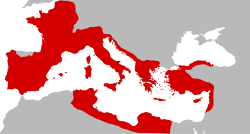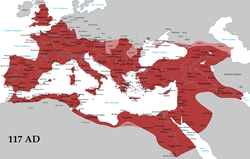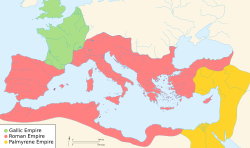Western Roman Empire
The Western Roman Empire was the western half of the Roman Empire, which was divided by Diocletian in 286 AD. The other half of the Roman Empire became known as the Eastern Roman Empire.
Western Roman Empire | |
|---|---|
| 395–476/480 | |
 The Western Roman Empire in 418 AD, following the abandonment of Britannia and the settlement of the Visigoths, Burgundians, and Suebi within imperial territory as foederati | |
| Status | Western division of the Roman Empire a |
| Capital | Mediolanum (395–402) Ravenna (402–455, 473–476) Romec (455–473) Spalatumd (475–480) |
| Capital-in-exile | Spalatum (475–480) |
| Common languages | Latin (official) Regional / local languages |
| Religion | Polytheistic Roman Religion until 4th century Nicene Christianity (state church) after 380 |
| Government | Autocracy |
| Notable emperors | |
• 395–423 | Honorius |
• 457–461 | Majorian |
• 474–480 | Julius Nepos |
• 475–476 | Romulus Augustulus |
| Legislature | Roman Senate |
| Historical era | Late antiquity |
• | 17 January 395 |
• | 4 September 476 |
• Murder of Emperor Julius Nepos | 25 April 480 |
| Area | |
| 395[1] | 2,000,000 km2 (770,000 sq mi) |
| Currency | Roman currency |
The Roman Empire had been in difficulties since 190 AD, when large Gothic tribes began moving into areas under Roman control. The Empire had weak leadership, which caused instability. Various power groups in the Roman armies kept trying to install their own emperors and killed those who belonged to other groups. That helped the invasions by the Germanic tribes.
Diocletian ended Rome's Crisis of the Third Century and tried to bring back stable government by dividing the empire into sections. The Western Empire included Iberia, France, southern Britain, Italy, North Africa and parts of Germany. The Eastern Empire included the Balkans, Turkey, the Levant and Egypt.
Rome ceased to be the capital from the time of the division. In 286, the capital of the Western Roman Empire became Mediolanum (now Milan). In 402, the capital was again moved, this time to Ravenna.

The division did not help the Western Empire, which came under increasing invasions from the north: the Ostrogoths, Huns, Franks, Visigoths and Burgundians. Its armies were brought back towards Rome and abandoned Britain and France. The Empire's economy could not cope since the increased need for military spending caused inflation. Citizens were unhappy with the rising taxes and rising prices.
In AD 398, Alaric led the Visigoths and began making attacks closer and closer to the capital. By 410, he had sacked Rome. In 455, the Vandals captured the city. In 476, the Goths captured the city.
The fall of the Western Roman Empire took place in 476 AD, when the leader of the Goths, Odoacer, removed Emperor Romulus Augustus. Odoacer became King of Italy, and the Western Roman Empire ended. By then, however, the empire had existed in name only, and the Emperor no longer had military, financial or political power.
Western Roman Empire Media
The Roman Republic before the conquests of Octavian
Roman Empire in AD 117 at its greatest extent, at the time of Trajan's death vassal states[2]
The organization of the Empire under the Tetrarchy
The division of the Empire after the death of Theodosius I, c. AD 395, superimposed on modern borders Western Court under Honorius Eastern Court under Arcadius
Gold solidus of Honorius
Related pages
References
- ↑ Taagepera, p. 24.
- ↑ Bennett 1997.
Other websites
- www.roman-empire.net
- De Imperatoribus Romanis Archived 2011-02-16 at the Wayback Machine








